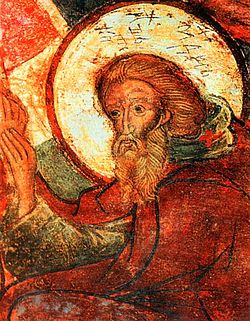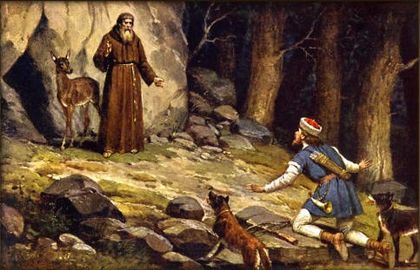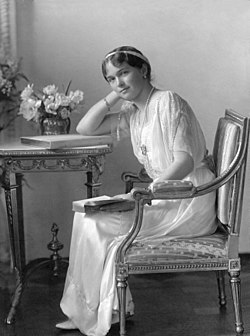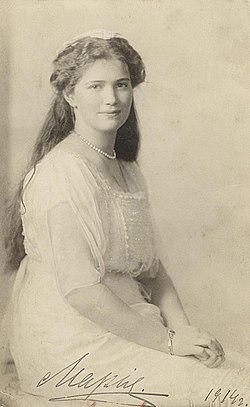Top Qs
Timeline
Chat
Perspective
July 4 (Eastern Orthodox liturgics)
From Wikipedia, the free encyclopedia
Remove ads
July 3 - Eastern Orthodox Church calendar - July 5

All fixed commemorations below are celebrated on July 17 by Old Calendar.[note 1]
For July 4, Orthodox Churches on the Old Calendar commemorate the Saints listed on June 21.
Saints
- Martyrs Theodotus[1][2][3][4] and Theodota, martyred with St. Hyacinth at Caesarea in Cappadocia (108)[5][6]
- Hieromartyr Theophilos, by the sword.[2][4][6][7]
- Saint Korilla (Cyrilla).[4][8][note 2]
- Hieromartyrs Innocent and Sabbatius, and 30 others with them, in Sirmium of Pannonia (304)[5][6][note 3]
- Hieromartyr Theodore of Cyrene, Bishop of Cyrene in Libya,[10][11][note 4] and with him Martyrs Cyprilla, Aroa, and Lucia (310)[2][4][5][6][12][13]
- Hieromartyr Donatus, Bishop of Libya,[2][5][6] and Monk-martyr Hilarion (c. 361-363)[4][14][note 5]
- Venerable Martha, mother of Symeon Stylites the Younger, of the Wonderful Mountain (551)[2][4][5][16][17]
- Saint Andrew of Crete, Archbishop of Crete, the Jerusalemite (712)[2][4][5][6][18][19][20][21]
- Saint Asclepias the Wonderworker.[2][4][6][22]
- Venerable Menignos.[2][4][6][23]
Remove ads
Pre-Schism Western saints
- Prophets Hosea and Haggai (6th-4th century BCE)[24] (see also: October 17, December 4, December 16)
- Saint Namphamon and Companions, of Carthaginian descent, he was martyred with several compatriots at Madaura in Numidia in North Africa and called 'the Archmartyr' (c. 180)[25][note 6]
- Saint Jucundian, a martyr in North Africa.[25][note 7]
- Saint Laurianus, Archbishop of Seville in Spain, he was martyred in Bourges in France (c. 544)[25][note 8][note 9]
- Saint Finbar, an Abbot of Innis-Doimhle,[note 10] in Wexford, Ireland (6th century)[25][26]
- Saint Bertha of Artois (Bertha of Blangy), a Frankish and Anglo-Saxon Abbess of noble blood (c. 725)[25][27][note 11]
- Saint Aurelian, a monk and Abbot of Ainay in France, he later became Archbishop of Lyons (895)[25][note 12]
- Saint Ulrich of Augsburg and Bavaria (973)[5][6][25][28][note 13][note 14]
- Saint Hatto, born of a noble Swabian family, he left all his property to the monastery of Ottobeuren in Germany, and became a monk there (985)[25]
- Saint Procopius of Sázava, Abbot of Sázava in Bohemia (1053)[25][29][note 15] (see also: April 1 - East )
Remove ads
Post-Schism Orthodox saints
- Burial of St. Andrew, Prince of Bogolubovo (1174)[5][6][30][31][32][33]
- Saint Michael Choniates, Metropolitan of Athens (1220)[2][4][5][34]
- Saint Andrew (Rublev), iconographer, of the Spaso-Andronikov Monastery, Moscow (1428)[4][5][6][32][33][35]
New martyrs and confessors
- Tsar Nicholas II,
- Tsaritsa Alexandra,
- Crown Prince Alexius
- Grand Duchesses Olga, Tatiana, Maria, and Anastasia, and with them:
- New Martyr Passion bearer Eugene Botkin, physician.
- New Hieromartyr Nilus, Hieromonk, of Poltava (1918)[5][6][31]
- New Hieromartyr Jonah (Sankov) the Athonite (1938)[4][37][note 16] (see also: June 21 )
- New Hieromartyrs Sava (Trlajic), Bishop of Gornji Karlovac (1941)[32][33][note 17] and Đorđe Bogić, Priest, of Nasice (1941)[5][6]
- New Hieromartyr Demetrius Kazansky, Priest (1942)[6][32][38]
Other commemorations
- Icon of the Mother of God of Galatea.[6][32][39][40]
- Translation of the relics (460-490) of St. Martin the Merciful, Bishop of Tours (397)[5][6][41][note 18] (see also: October 12, November 11, November 12)
- Uncovering of the relics of St. Euthymius the Wonderworker, Archimandrite, of Suzdal (1507)[5][6][31][32][33][42][note 19]
- Repose of Hieroschemamonk John, founder of Sarov Monastery (1737)[5]
- Repose of Righteous Confessor Andrew the Russian, at Cairo (c. 1850)[5][31]
- Slaying of General Dragoljub (Drazha) Mihailovic of Serbia (1946)[5]
- Repose of Archpriest Tikhon Pelikh of Sergiyev Posad (1983)[5]
Remove ads
Icon gallery
- Fresco of St. Andrew of Crete, Archbishop of Crete, the Jerusalemite.
- St. Laurianus, Archbishop of Seville in Spain, martyr.
- St. Procopius of Sázava, Abbot of Sázava in Bohemia.
- Lead seal of Michael Choniates as Metropolitan of Athens.
- St. Alexandra, Empress of Russia.
- Tsesarevich Alexei in 1916.
- Grand Duchess Olga.
- Grand Duchess Tatiana.
- Grand Duchess Maria.
- Grand Duchess Anastasia.
- Passion bearer Eugene Botkin, physician.
- New Hieromartyr Sava (Trlajic), Bishop of Gornji Karlovac.
- New Hieromartyr Sava (Trlajic), Bishop of Gornji Karlovac.
- New Hieromartyr Đorđe Bogić, Priest, of Nasice.
- St. Martin the Merciful.
- St. Euthymius the Wonderworker, Archimandrite, of Suzdal.
- General Draža Mihailović of Serbia.
Remove ads
Notes
- The notation Old Style or (OS) is sometimes used to indicate a date in the Julian Calendar (which is used by churches on the "Old Calendar").
The notation New Style or (NS), indicates a date in the Revised Julian calendar (which is used by churches on the "New Calendar"). - "On this day we commemorate Saint Donatus, Bishop of Libya, though Galanos posits that this refers to Saint Donatus, Bishop of Arezzo."[15]
- Born in Pannonia, now Hungary, he was ordained deacon in Milan in Italy and later became Archbishop of Seville in Spain. He was martyred in Bourges in France.
- See also: (in Spanish) Laureano (santo). Wikipedia. (Spanish Wikipedia).
- Most likely present-day Inch, County Wexford.
- A lady of high station, after her husband's death she became a nun at the convent of Blangy in Artois in France, which she had founded and where she became abbess.
- See also: (in French) Aurélien (archbishop). Wikipédia. (French Wikipedia).
- Also Uldaricus, Udalric. Born in Augsburg in Germany, at the age of seven he was sent to the monastery of St Gall in Switzerland. In 923 he became Bishop of Augsburg and protected his people against the invading Magyars. In his old age he lived as a monk at St Gall. In 993 he became the first person to be canonised by the Pope of Rome.
- Born in Czechia, he was ordained in Prague; later he became a hermit and finally founded the monastery of Sazava.
- (in Russian) Санков, Иван Андреевич.
- See also: (in Serbian) Сава Горњокарловачки. Википедији. (Serbian Wikipedia).
- See also: (in Russian) Евфимий Суздальский. Википедии. (Russian Wikipedia).
Remove ads
References
Sources
Wikiwand - on
Seamless Wikipedia browsing. On steroids.
Remove ads





















